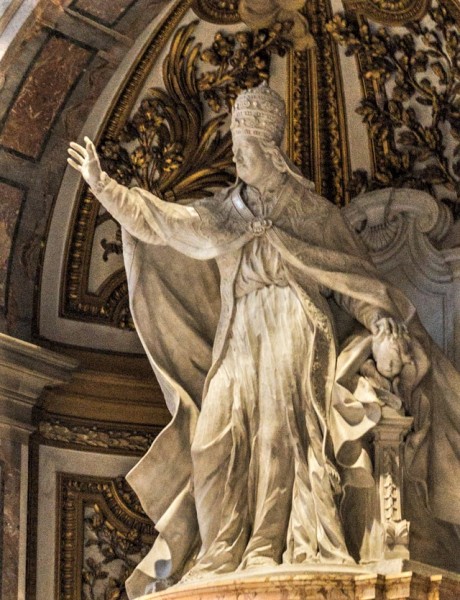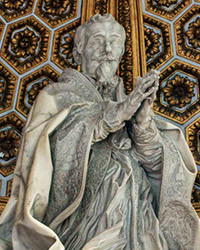
Pietro Bracci, Tombstone of Pope Benedict XIV, fragment, personifications of Divine Wisdom and Selflessness, Basilica of San Pietro in Vaticano

Tombstone of Pope Benedict XIV, Basilica of San Pietro in Vaticano

Pietro Bracci, Tombstone of Pope Benedict XIV, Basilica of San Pietro in Vaticano

Pietro Bracci, Tombstone of Pope Benedict XIV, image of the Pope, Basilica of San Pietro in Vaticano

Tombstone of Pope Benedict XIV, Basilica of San Pietro in Vaticano

Tombstone of Pope Benedict XIV, fragment, Basilica of San Pietro in Vaticano
When Benedict XIV died in 1758, he did not have to worry about his funerary monument. A group of cardinals whom he appointed, commissioned its creation as early as the initial years of the pope’s pontificate. In this way a new tradition was born – it was no longer the family of the deceased successor of St. Peter, as had been the case for centuries – but a group of his sympathizers and beneficiaries who were responsible for the appropriate commemoration of the head of the Church. And thus a competition was organized in 1743 for the funerary monument of the pope and it was won by a significant artist of those times Pietro Bracci.
When Benedict XIV died in 1758, he did not have to worry about his funerary monument. A group of cardinals whom he appointed, commissioned its creation as early as the initial years of the pope’s pontificate. In this way a new tradition was born – it was no longer the family of the deceased successor of St. Peter, as had been the case for centuries – but a group of his sympathizers and beneficiaries who were responsible for the appropriate commemoration of the head of the Church. And thus a competition was organized in 1743 for the funerary monument of the pope and it was won by a significant artist of those times Pietro Bracci.
It was an artist, who was well-known at the pope’s court. He had already completed several works for the pope, including the monument found in the Vatican Basilica of the queen without land, meaning Maria Clementina Sobieska (The Funerary Monument of Maria Clementina Sobieska) as well as the statues of the saints, founders of the orders (Vincent a Paulo, and Jerome Emiliani). All of them were characterized by astute elegance and finesse of execution. And this time Bracci also went with a tried repertoire of artistic means. However, a novelty was depicting the pope not – as was customary – enthroned but standing. And so in a niche, filled with multi-colored marble and decorated with gilded stuccos, we can see the white statue of the pope as if gently brushed by a breeze. With his right hand, he blesses the faithful, while the left is resting on the head of a putto, which is in fact a gigantic snuffbox – a reference to one of the pope's greatest passions, meaning using snuff. Below there are two allegories, which flank the door imitating the entrance to the pope's tomb. One of these is Divine Wisdom (with a book), and the other – is Selflessness, shown in the company of a putto discarding a bushel of coins. Of course, they are a direct reference to the figure of the pope and his pontificate, which were characterized by wisdom and culture, but also honesty in managing the finances of the State of the Church.
Bracci was the author of a concept of an elegant monument, but also one that was deeply rooted in the tradition of papal monuments, but above all it was a reference to his great predecessor – Gian Lorenzo Bernini, whose works were still considered a symbol of unmatched excellence. Similarly to him in his Funerary monument of Alexander VII, Bracci placed the statue of the pope above the door, suggesting the gate to eternity. However, the doors are flanked by only two allegories (not four as was the case with Bernini’s work), set at the base of a high plinth, where the pope stands, due to which the whole composition acquired a more dignified and monumental character.

Not all sculptures (similarly to Bernini), were made by Bracci himself. His signature can be found on the book held by the allegory of Wisdom (Sapienza Divina) and on the hem of the pope's robes. On both of them, there is a Latin inscription: "The Roman Pietro Bracci created and completed this work”. The second allegory, which seems to be of particular interest was completed by his aide – Gaspare Sibilla. His signature can be found on one of the coins falling out of the bushel held by the personification of selflessness. The inscription visible there also informs us, that the artist not also completed the statue, but also created it, thus providing evidence of his talent and artistic independence. This is an interesting show of the then artistic life allowing us to notice the scale of emancipation of individual artists, leaving information for future generations not only in the form of their surname but also as far as the works which they had completed.

The monument was unveiled only eleven years after the pope’s death (1769) since the popular at that time Bracci was occupied by numerous other commissions. It was placed near the Gregorian Chapel (Cappella Gregoriana) and it was the last funerary monument of the Baroque completed in the Vatican Basilica and at the same time the last gust of the magnificent style commenced by Bernini. Subsequent monuments would be created in the new, Classicist style.






















